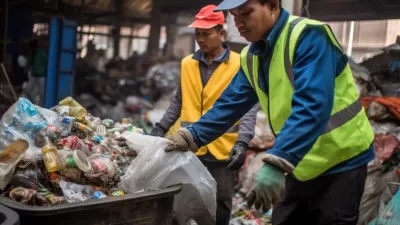Over the next few decades, half of global economic growth is predicted to come from the slums of developing world cities. Gaia Vince believes the key to the coming urban revolution is how these shantytowns evolve.
"[A]lthough scenes of squalor, accumulation of rubbish and polluted waters look like destitution, slums are rich seedlings for the vibrant cities of the future," says Vince. "Many of today's established capitals, including London and New York, launched from similar embryonic beginnings." There are currently 1 billion dwellers in informal housing around the world and the United Nations predicts that one in four people will become an urban squatter by 2030, increasing to one in three by 2050.
When slum dwellers organize together, they can create transformative innovations. For example, in Delhi, the Children's Development Khazana is run by street children and allows 1,000 youth to safely store their earnings. In Pakistan, residents of the Orangi slum built their own sewerage system in the 1980s and successfully reduced infant mortality. "Cooperation, whether to achieve wider policy change and improvement in working conditions or build essential infrastructure, is a slum’s biggest strength and is essential to nurture as cities 'upgrade' their poorest areas," says Vince, though he warns, "That's not to glorify life in these communities."
"Governments are beginning to accept the social wealth of these existing communities," continues Vince, "and realising that the best way to capitalise on that is to incorporate these dynamic, lively parts of the city into the established whole, by providing the tools for growth, integration and citizen strength." Medellin, Colombia, the former murder capital of the world, was transformed "from terrible conditions to light modernity" and "the murder rate has plummeted." However, only those with independent governance and strong finances may have the resources to implement large-scale change.
Vince concludes: "As most of the urban growth in coming decades will be in poor countries, particularly in Asia and Latin America (Africa’s urbanisation is stark and rapid only in a few countries, although this could change), it is associated with a general rise in global resource use as people improve their standard of living. The challenge then is to create the most sustainable cities – ones where people lead dignified lives without generating excessive waste and pollution."
FULL STORY: Slums and the future of cities

Study: Maui’s Plan to Convert Vacation Rentals to Long-Term Housing Could Cause Nearly $1 Billion Economic Loss
The plan would reduce visitor accommodation by 25,% resulting in 1,900 jobs lost.

North Texas Transit Leaders Tout Benefits of TOD for Growing Region
At a summit focused on transit-oriented development, policymakers discussed how North Texas’ expanded light rail system can serve as a tool for economic growth.

Why Should We Subsidize Public Transportation?
Many public transit agencies face financial stress due to rising costs, declining fare revenue, and declining subsidies. Transit advocates must provide a strong business case for increasing public transit funding.

How to Make US Trains Faster
Changes to boarding platforms and a switch to electric trains could improve U.S. passenger rail service without the added cost of high-speed rail.

Columbia’s Revitalized ‘Loop’ Is a Hub for Local Entrepreneurs
A focus on small businesses is helping a commercial corridor in Columbia, Missouri thrive.

Invasive Insect Threatens Minnesota’s Ash Forests
The Emerald Ash Borer is a rapidly spreading invasive pest threatening Minnesota’s ash trees, and homeowners are encouraged to plant diverse replacement species, avoid moving ash firewood, and monitor for signs of infestation.
Urban Design for Planners 1: Software Tools
This six-course series explores essential urban design concepts using open source software and equips planners with the tools they need to participate fully in the urban design process.
Planning for Universal Design
Learn the tools for implementing Universal Design in planning regulations.
City of Santa Clarita
Ascent Environmental
Institute for Housing and Urban Development Studies (IHS)
City of Grandview
Harvard GSD Executive Education
Toledo-Lucas County Plan Commissions
Salt Lake City
NYU Wagner Graduate School of Public Service




























